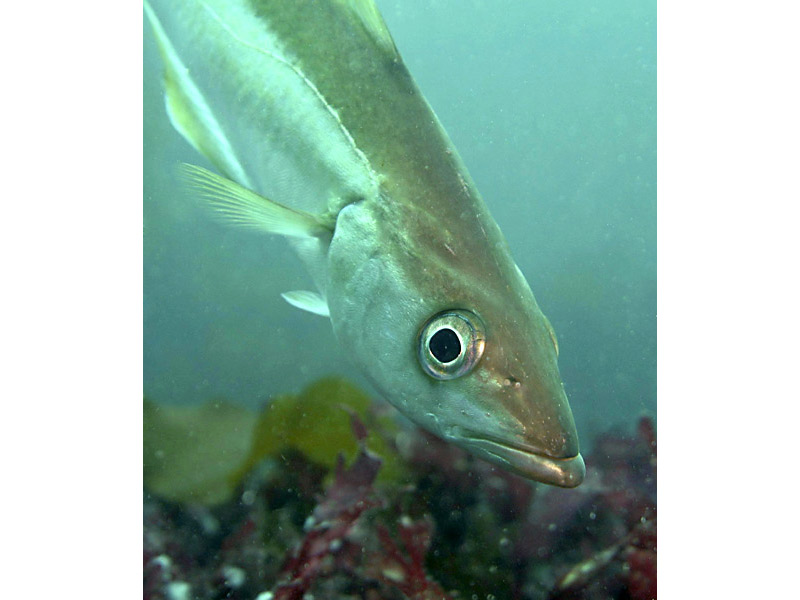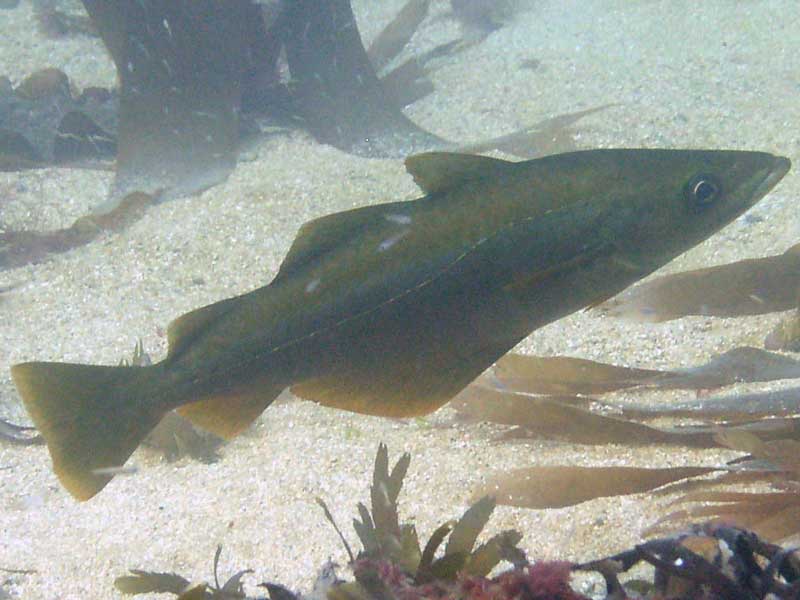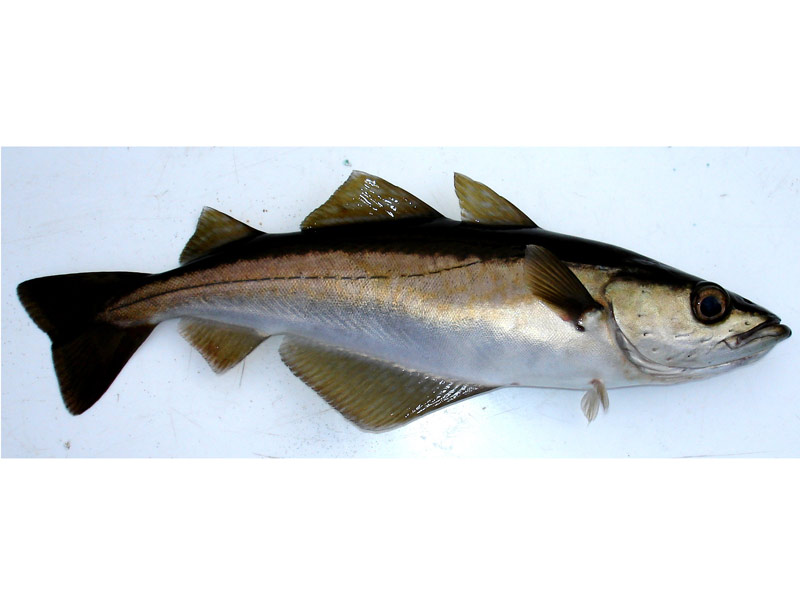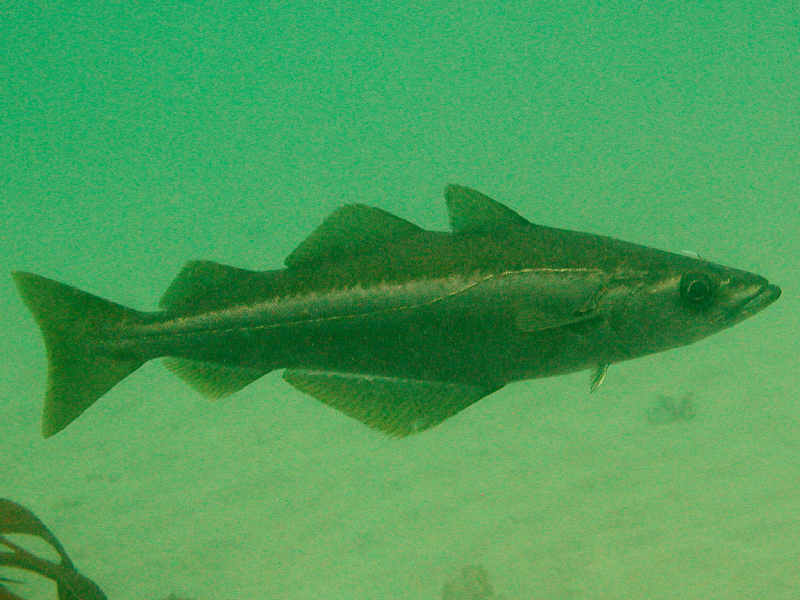Pollack (Pollachius pollachius)
Distribution data supplied by the Ocean Biodiversity Information System (OBIS). To interrogate UK data visit the NBN Atlas.Map Help
| Researched by | Sonia Rowley | Refereed by | Admin |
| Authority | (Linnaeus, 1758) | ||
| Other common names | - | Synonyms | - |
Summary
Description
Recorded distribution in Britain and Ireland
This species is found off all coasts of Britain and Ireland.Global distribution
-Habitat
This species can be found to >100 meters depth, either solitary or in small shoals. It is both an offshore pelagic or coastal benthic species found on the sea bed around rocks, wrecks and kelp forests.Depth range
-Identifying features
- Large fish up to 130 cm in length and 14 kg in weight.
- Eyes are yellow and conspicuously large.
- Three dorsal fins with the first being triangular and 2 anal fins.
- The lateral line is dark green and arches over the pectoral fin before straightening out.
- Colour typically silvery with a brown or green back and yellow-silver sides.
Additional information
This is both a solitary and shoaling species, more likely to shoal during spawning events. Spawning in Pollachius pollachius occurs up to ca 100 meters depth between January and April, with the greatest intensity during March (Wheeler, 1969). The eggs and larvae drift in the water column towards the shallower coastal waters. Within the first year, juveniles can reach up to 17 cm in length. Juveniles live amongst rocks and algae mainly feeding on crustaceans in the shallows and then venture out to 40-100 m when about three years old with a body length of up to 40 cm (Wheeler, 1969). Young juveniles may also be found in estuaries.Large, older individuals of Pollachius pollachius are usually darker in colour, where juveniles are green, brown or occasionally crimson and gold. Such colouration ensures the juveniles are inconspicuous, although they may be easily confused with juveniles of Pollachius virens (Saithe) and other cod species. Adults of Pollachius virens have a straight lateral line and equal length jaws. Other similar species that may be confused for Pollachius pollachius are: Merlangius merlangus (whiting) that has an upper jaw longer than the lower, and Melanogrammus aeglefinus, that has a black pectoral spot and a black lateral line (Gibson et al., 2001).
Pollachius pollachius feeds on deep sea prawns, Clupea harengus, Ammodytes tobianus, Sprattus sprattus, Mallotus villosus and other open water fish, and can be observed hanging above or within kelp forests and wrecks. This species hunts singly or in small groups by lying close to the sea bed watching sand eels shoaling above them. They suddenly dart up and grab their prey then resume their former position to let the shoal re-group. Such behaviour has been observed in juveniles hunting on groups of mysid shrimps or Gobius flavesecens (Naylor, 2003).
Pollachius pollachius has a small commercial fishery often caught with Gadus morhua in gill nets, traps or long lines. However, pollack is a popular species with anglers as they readily take bait (Wheeler, 1969).
Listed by
- none -
Bibliography
Bruce, J.R., Colman, J.S. & Jones, N.S., 1963. Marine fauna of the Isle of Man. Liverpool: Liverpool University Press.
Costello, M.J., Bouchet, P., Boxshall, G., Emblow, C. & Vanden Berghe, E., 2004. European Register of Marine Species [On-line]. http://www.marbef.org/data/erms.php,
Crothers, J.H. (ed.), 1966. Dale Fort Marine Fauna. London: Field Studies Council.
Dipper, F., 2001. British sea fishes (2nd edn). Teddington: Underwater World Publications Ltd.
Gibson, R., Hextall, B. & Rogers, A., 2001. Photographic guide to the sea and seashore life of Britain and north-west Europe. Oxford: Oxford University Press.
Hayward, P., Nelson-Smith, T. & Shields, C. 1996. Collins pocket guide. Sea shore of Britain and northern Europe. London: HarperCollins.
Howson, C.M. & Picton, B.E., 1997. The species directory of the marine fauna and flora of the British Isles and surrounding seas. Belfast: Ulster Museum. [Ulster Museum publication, no. 276.]
Moen, F.E. & Svensen, E., 2004. Marine Fish & Invertebrates of Northern Europe. Southend-on-Sea: Aqua Press.
Muus, B.J. & Dahlstrom, P., 1974. Collins guide to the sea fishes of Britain and North-Western Europe. Wm Collins Sons & Co. Ltd: London.
Naylor, P., 2003. Great British Marine Animals. Plymouth: Sound Diving Publications.
Wheeler, A., 1969. The fishes of the British Isles and north-west Europe. London: Macmillan.
Datasets
Centre for Environmental Data and Recording, 2018. Ulster Museum Marine Surveys of Northern Ireland Coastal Waters. Occurrence dataset https://www.nmni.com/CEDaR/CEDaR-Centre-for-Environmental-Data-and-Recording.aspx accessed via NBNAtlas.org on 2018-09-25.
Cofnod – North Wales Environmental Information Service, 2018. Miscellaneous records held on the Cofnod database. Occurrence dataset: https://doi.org/10.15468/hcgqsi accessed via GBIF.org on 2018-09-25.
Environmental Records Information Centre North East, 2018. ERIC NE Combined dataset to 2017. Occurrence dataset: http://www.ericnortheast.org.ukl accessed via NBNAtlas.org on 2018-09-38
Fenwick, 2018. Aphotomarine. Occurrence dataset http://www.aphotomarine.com/index.html Accessed via NBNAtlas.org on 2018-10-01
Fife Nature Records Centre, 2018. St Andrews BioBlitz 2014. Occurrence dataset: https://doi.org/10.15468/erweal accessed via GBIF.org on 2018-09-27.
Fife Nature Records Centre, 2018. St Andrews BioBlitz 2015. Occurrence dataset: https://doi.org/10.15468/xtrbvy accessed via GBIF.org on 2018-09-27.
Isle of Wight Local Records Centre, 2017. IOW Natural History & Archaeological Society Marine Records. Occurrence dataset: https://doi.org/10.15468/7axhcw accessed via GBIF.org on 2018-09-27.
Kent & Medway Biological Records Centre, 2017. Fish: Records for Kent. Occurrence dataset https://doi.org/10.15468/kd1utk accessed via GBIF.org on 2018-09-27.
Manx Biological Recording Partnership, 2017. Isle of Man wildlife records from 01/01/2000 to 13/02/2017. Occurrence dataset: https://doi.org/10.15468/mopwow accessed via GBIF.org on 2018-10-01.
Manx Biological Recording Partnership, 2022. Isle of Man historical wildlife records 1990 to 1994. Occurrence dataset:https://doi.org/10.15468/aru16v accessed via GBIF.org on 2024-09-27.
Merseyside BioBank., 2018. Merseyside BioBank (unverified). Occurrence dataset: https://doi.org/10.15468/iou2ld accessed via GBIF.org on 2018-10-01.
Merseyside BioBank., 2018. Merseyside BioBank Active Naturalists (unverified). Occurrence dataset: https://doi.org/10.15468/smzyqf accessed via GBIF.org on 2018-10-01.
National Trust, 2017. National Trust Species Records. Occurrence dataset: https://doi.org/10.15468/opc6g1 accessed via GBIF.org on 2018-10-01.
NBN (National Biodiversity Network) Atlas. Available from: https://www.nbnatlas.org.
North East Scotland Biological Records Centre, 2017. NE Scotland fish records 1800-2010. Occurrence dataset: https://doi.org/10.15468/kjrwnd accessed via GBIF.org on 2018-10-01.
OBIS (Ocean Biodiversity Information System), 2025. Global map of species distribution using gridded data. Available from: Ocean Biogeographic Information System. www.iobis.org. Accessed: 2025-05-06
South East Wales Biodiversity Records Centre, 2018. SEWBReC Fish (South East Wales). Occurrence dataset: https://doi.org/10.15468/htsfiy accessed via GBIF.org on 2018-10-02.
Citation
This review can be cited as:
Last Updated: 03/07/2008






